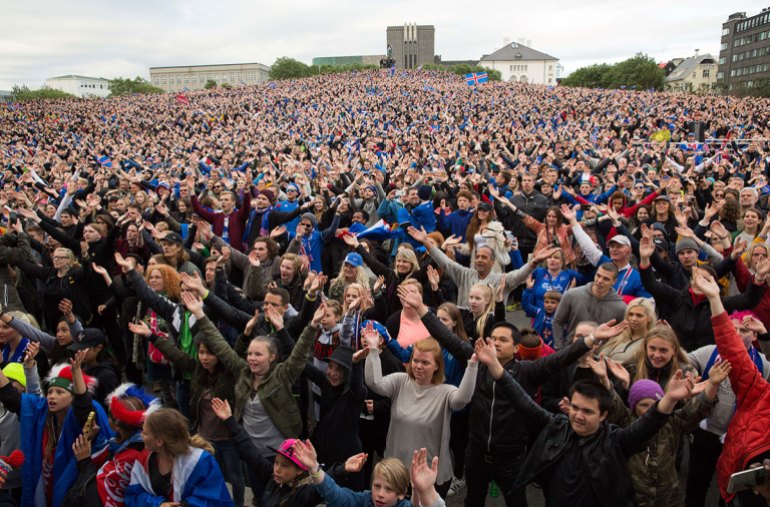Reykjavik to Rabat: Morocco’s twist to the Viking thunderclap
Inside Al Thumama Stadium in Qatar, thousands of Morocco fans stood with their hands outstretched over their heads during the quarter-final against Portugal.
The whistling, clapping and jeering gave way to complete silence. You could hear a cough at the other end of the stadium.
Then, a drum beats and a clap is heard. The fans, draped in the familiar red and green of Morocco, smack their hands in unison, creating a thunderous noise that rings around the stadium as they shout “sir” – which means “go” – before falling silent again.
Clap, “sir”. The process is repeated a few seconds later, with the sound booming and echoing across the stadium as the Moroccan players harry against the higher-ranked Portugal side on Saturday.
The claps become more frequent, eventually reaching a rousing crescendo followed by a post-climactic round of appreciative applause.
The Moroccan fans’ use of this so-called “Viking clap” epitomises their passion for their team at World Cup 2022.
Arguably one of the liveliest sets of fans at the tournament, they have fervently cheered on the Atlas Lions to the steady beat of their drums through all four of their World Cup games.
This is the type of CLAP you’ll get when you get your first round of 16 qualification after 36 years.
Moroccan fans are having their best day here ☺️ (Morocco, Africa) (@ShamoonHafaez)#CANMAR pic.twitter.com/1x86zUzWR3
— Statman Diligent Ali 🤭 (@alidiligent39) December 1, 2022
What is the Viking clap?
Iceland fans were seen carrying out the Viking clap at Euro 2016 which took place in France. A big crowd of Icelandic fans would stay behind after the game to perform the clap with their players.
The loud, intimidating sight left such a visceral impression on the tournament that French fans and players began to perform it after their matches.
The origins of the clap are difficult to pinpoint and most likely did not begin on the Icelandic shores.
Videos have emerged of fans of the French club side Lens performing the clap while shouting their team’s name a few years before Euro 2016. Supporters of the Scottish side Motherwell – apparently inspired by a scene from the film 300 – have also been performing a similar clap for many years.

Since Iceland’s use of the clap at the 2016 European Championships, its popularity has spread worldwide and can now be heard at Kerala Blasters games in India and among supporters of Perspolis Football Club in Iran.
There can be parallels drawn to Iceland’s unexpected success at the Euro 2016, where they reached the quarter-finals beating England along the way.
Morocco have made it to the World Cup quarter-finals for the first time in their history, beating second-ranked Belgium and knocking out Spain in the process.
The adapted clap is an apt reflection of how massive and loud Morocco’s support has been throughout the tournament.
If you want to understand the importance of the 12th man, look no further than Moroccan 🇲🇦 fans at this World Cup. Their support is immense.
They have come in thousands to the stadiums. Many live in Qatar while others flew in from Morocco and across the world. Dima Maghrib. pic.twitter.com/Wqym9qcDR4
— Usher Komugisha (@UsherKomugisha) December 7, 2022
“I feel so enthusiastic and very proud of my country. I love Morocco, and when I hear all of us singing and clapping together, I want to support the team even more, no matter how bad they are playing,” said Marwa Mifta, a 38-year-old doctor from Rabat, at the match against Portugal.
Reda el-Harrachi, 30, said when she hears the thunderclap inside the stadium, she gets “goosebumps everywhere”.
Alasdair Howorth, a journalist specialising in African football, believes that Moroccan fans have made this World Cup a “home tournament” for their team.
“It can’t be underestimated how big Moroccan and Tunisian fans have been at this World Cup,” Howorth said, adding that the media placed a lot of scrutiny on Qatar and this World Cup, but what “hasn’t been talked about enough is how important it is having a World Cup in the Arab world“.
The support they have received in Qatar, the ease of travel to and around the country, and the sizable diasporas have resulted in what Howorth describes as a “real connection” between the fans and this World Cup.
“Morocco has one of the best fan cultures in the world in terms of passion,” he says. “I think it is brilliant that the world has finally seen it because it has been there for a very long time.”




